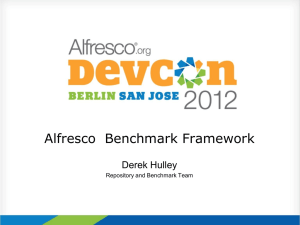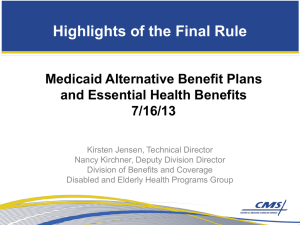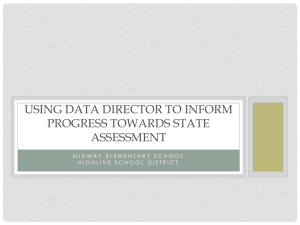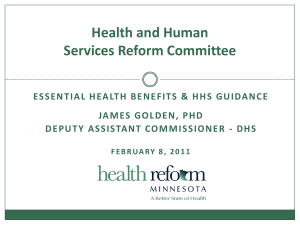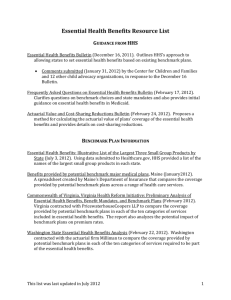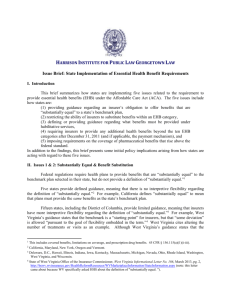1204POPULATIONEDWARDS (Slide 1)
advertisement
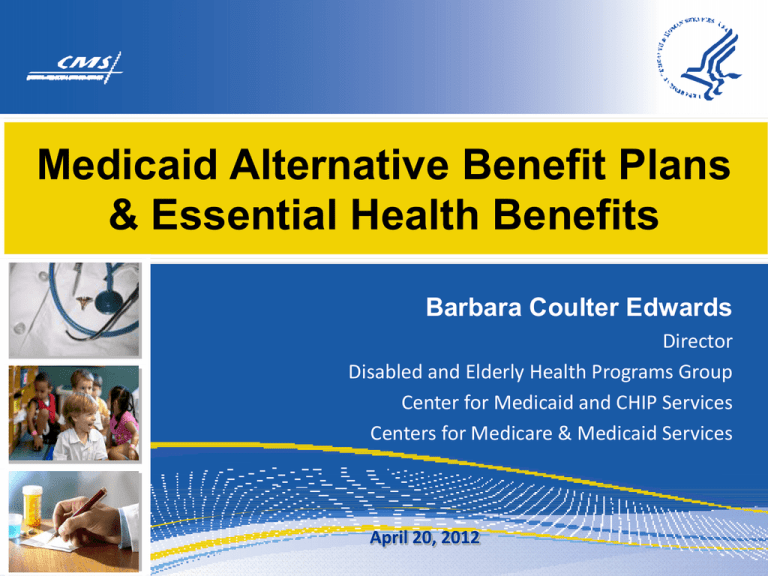
Medicaid Alternative Benefit Plans & Essential Health Benefits Barbara Coulter Edwards Director Disabled and Elderly Health Programs Group Center for Medicaid and CHIP Services Centers for Medicare & Medicaid Services April 20, 2012 Alternative Benefit Plans Today Deficit Reduction Act (DRA) of 2005 created new section 1937 of the Social Security Act Increased flexibility for States to provide Medicaid coverage through tailored “benchmark” or “benchmark equivalent” benefit packages to specific populations Mandatory enrollment limited to certain Medicaid beneficiary groups Alternative Benefit Plans Today Exempt from mandatory enrollment 1. 2. 3. 4. 5. 6. Blind or disabled Medically needy/frail Pregnant women Terminally ill individuals receiving hospice care Individuals entitled to benefits under Medicare Etc.. Alternative Benefit Plans Today “Benchmark” coverage is a benefit plan that is either the same as: 1. Federal employees health benefit coverage; 2. State employees health benefit coverage; or 3. Coverage offered by the health maintenance organization (HMO) with the largest insured commercial non-Medicaid enrolled population in the State. 4. Secretary-approved coverage – Any other health benefits coverage that the Secretary determines, upon application by a State, provides appropriate coverage for the population proposed to be provided such coverage Alternative Benefit Plans Today “Benchmark-Equivalent” Coverage 1. Benefit package has an aggregate actuarial value that is at least equivalent to that of one of the Benchmark Benefit packages 2. Must include coverage for following services: Inpatient and outpatient hospital Physician’s surgical & medical Lab and x-ray Well baby/well child care (including immunizations) Emergency services Family planning services and supplies Mental health services Prescription drugs Other appropriate preventative services as designated by the Secretary Alternative Benefit Plans Today States may provide “benchmark” or “benchmarkequivalent” coverage by obtaining employer sponsored health plans. The State must assure that the employer sponsored plans meet the requirements of the benchmark/benchmark-equivalent coverage, including economy and efficiency. A State may provide coverage through a combination of employer sponsored health plans and additional benefits coverage provided by the State. Alternative Benefit Plans Today States must assure enrollee access, through benchmark or benchmark-equivalent coverage or otherwise, to rural health clinic services and FQHC services. Payments must be made in accordance with the Medicaid payment provisions for rural health clinics and FQHC services. Alternative Benefit Plans Today States must provide public notice and reasonable opportunity to comment before submitting benchmark/benchmark-equivalent plans and/or requesting changes to approved plans. Alternative Benefit Plans Today 11 States, the District of Columbia, Guam and Puerto Rico have implemented Medicaid Alternative Benefit plans. Wisconsin implemented a plan equal to the commercial HMO plan with the largest non-Medicaid enrollment in the States The following States and the District of Columbia implemented Secretary approved benefit plans: Connecticut (early option) Kentucky District of Columbia (early option) Minnesota (early option) Guam (early option) Missouri New York Puerto Rico (early option) Idaho Virginia Kansas Washington West Virginia Alternative Benefit Plans Today Effective March 23, 2010 Optional coverage of newly eligible prior to 2014 (may be phased in). Benefits must consist of benchmark or benchmark-equivalent coverage or full Medicaid State Plan Benchmark and benchmark-equivalent benefit coverage for all enrollees must include family planning services and supplies and comply with mental health parity Benchmark-equivalent coverage must include prescription drugs and mental health services Alternative Benefit Plans 2014 Effective January 1, 2014 New expansion population of adults required to receive benefits through a Section 1937 Alternative Benefit Plan MAGI eligible adults must receive benefits under Section 1937 Alternative Benefit Plan Any benchmark/benchmark-equivalent plan must provide at least the essential health benefits as defined by the Secretary Alternative Benefit Plans 2014 Impact All States will operate at least one Alternative Benefit Plan Each State required to identify EHB plan Benchmark plans that can be referenced as EHB benchmark plans State’s largest non-Medicaid HMO State’s employee health plan FEHPG Blue Cross/Blue Shield plan State could also select full Medicaid benefit plan as coverage package Alternative Benefit Plans 2014 Impact Allowing multiple Alternative Benefit Plans, EHB reference plans Supplementation of benefits in benchmark may be required to insure that all EHBs are offered in the State No default EHB benchmark plan in Medicaid, States required to submit an Alternative Benefit Plan State Plan Amendment to implement this change Future Considerations Adding the ability for States to offer long-term services and supports in addition to 1905(a) services within the Alternative Benefit Plans Allowing mandatory enrollment exemptions to apply to people in the VIII group Implementing mental health parity within Alternative Benefit Plans How to keep Alternative Benefit Plans/EHB “current” Issuances/Publications SMD letter – 3/31/06 - Benchmark Benefit Plan Option (now referred to as Medicaid Alternative Benefit plan) SHO letter – 4/9/10 - New Option for Coverage of Individuals Final rule – 4/30/10 - http://www.gpo.gov/fdsys/pkg/FR2010-04-30/pdf/2010-9734.pdf SHO letter – 7/2/11 - Family Planning State Option & New Benefit Rules for Benchmark Benefit Plans



